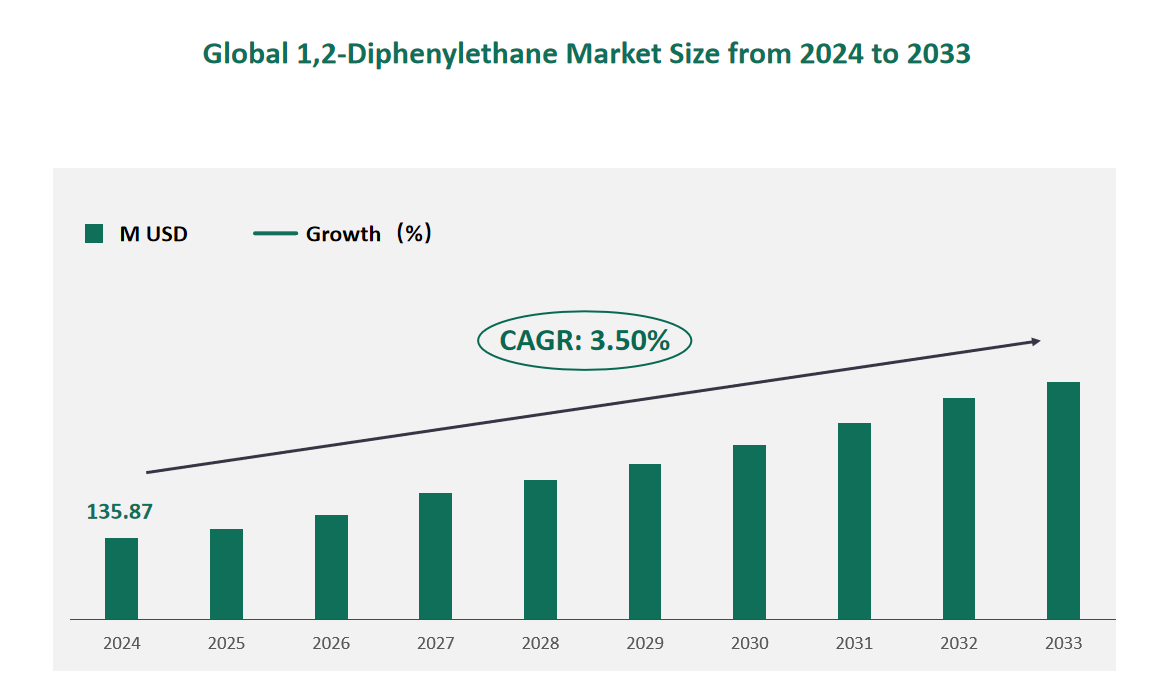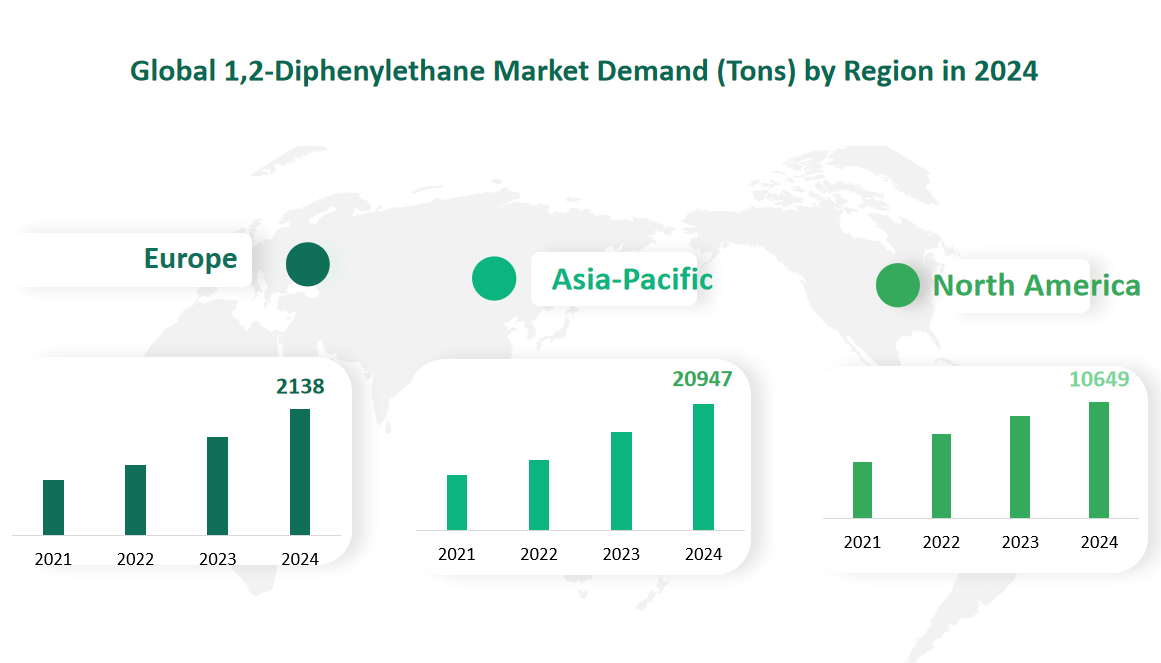1 Global 1,2-Diphenylethane Market Size (Value) and CAGR (2024-2033)
In 2024, the global 1,2-Diphenylethane market was valued at USD 135.87 million, with a CAGR of 3.50% from 2024 to 2033.
1,2-Diphenylethane (C14H14), also known as bibenzyl and symmetric diphenylethane, is an important intermediate in organic synthesis, mainly used in organic synthesis. Its sulfonated product can be used as an excellent leather tanning agent, and its dehydrogenation product is an important raw material for the production of optical brighteners and dyes. Due to the development of a new type of high-efficiency flame retardant, decabromodiphenyl ethane, its application is more extensive.
Figure Global 1,2-Diphenylethane Market Size (M USD) and CAGR 2024-2033

2 1,2-Diphenylethane Market Drivers
One of the primary drivers of the 1,2-Diphenylethane market is the increasing demand from the chemical and pharmaceutical industries. 1,2-Diphenylethane serves as a crucial intermediate in the synthesis of various fine chemicals, flame retardants, and pharmaceuticals. For instance, it is used as a raw material for the production of decabromodiphenylethane, a high-performance flame retardant with broad applications in transportation, electrical and electronic equipment, furniture, and building materials. The growing need for flame retardants, driven by stricter safety regulations and increasing consumer awareness, is a significant factor boosting the market.
Technological advancements in the production processes of 1,2-Diphenylethane are also contributing to market growth. Manufacturers are continuously seeking ways to improve the efficiency and sustainability of their production methods. For example, the development of new catalysts and reaction conditions has led to higher yields and reduced environmental impact. These advancements not only lower production costs but also enhance the overall quality and purity of the product, making it more attractive to end-users.
3 1,2-Diphenylethane Market Challenges
One of the significant challenges in the 1,2-Diphenylethane market is the complexity and environmental impact of its production processes. Traditional methods of synthesizing 1,2-Diphenylethane often involve harsh reaction conditions and the use of hazardous chemicals, such as aluminum trichloride. These processes can generate significant amounts of waste and pollutants, posing environmental and health risks.
The market is also highly sensitive to fluctuations in raw material prices. Key raw materials for 1,2-Diphenylethane production include benzyl chloride, benzene, and 1,2-dichloroethane (EDC). These materials are derived from petrochemicals, making their prices highly susceptible to changes in crude oil prices and global economic conditions.
The environmental and health impacts of 1,2-Diphenylethane production and use are another significant challenge. The compound itself, as well as its by-products, can be harmful to the environment and human health if not handled properly. High concentrations of 1,2-Diphenylethane can cause irritation and have narcotic effects, posing risks to workers and the surrounding communities.
4 Global 1,2-Diphenylethane Market Size and Share by Type in 2024
In 2024, the Purity ≥ 99% segment is expected to account for 117.66 million USD, representing approximately 86.60% of the total market value. This high-purity product is characterized by its high content of the main component, minimal impurities, and superior quality. It is used in applications requiring high precision and purity, such as industrial analysis, chemical experiments, and the production of high-performance flame retardants.
For instance, high-purity 1,2-Diphenylethane is a key intermediate in the synthesis of decabromodiphenylethane, a flame retardant with excellent thermal stability and non-toxicity. It is also used as a heat transfer oil additive in the pharmaceutical industry, ensuring precise temperature control during the manufacturing process. Additionally, it is employed in the production of various fine chemicals and intermediates, where high purity is essential for consistent product quality.
The Purity < 99% segment is projected to contribute 18.21 million USD, making up the remaining 13.40% of the market. This type of 1,2-Diphenylethane contains a significant amount of the main component but has higher levels of interfering impurities. It is suitable for applications where high purity is not critical, such as general chemical analysis and synthetic preparation.
Table Global 1,2-Diphenylethane Market Size and Share by Type in 2024
Type | Market Size (M USD) 2024 | Market Share 2024 |
Purity ≥ 99% | 117.66 | 86.60% |
Purity < 99% | 18.21 | 13.40% |
5 Global 1,2-Diphenylethane Market Consumption (Tons) and Share by Application in 2024
In 2024, the global 1,2-Diphenylethane market is projected to consume a total of 40,492 tons, with the majority of this consumption driven by the chemical industry. Specifically, the chemical industry is expected to consume 35,250 tons, accounting for approximately 87.05% of the total consumption. This high consumption is attributed to the extensive use of 1,2-Diphenylethane as an intermediate in the synthesis of various fine chemicals, flame retardants, and other specialty products. For instance, it is a key raw material in the production of decabromodiphenylethane, a high-performance flame retardant widely used in polymers and plastics.
The pharmaceutical industry is another significant consumer of 1,2-Diphenylethane, with an estimated consumption of 3,173 tons in 2024, representing about 7.84% of the total market. In this sector, 1,2-Diphenylethane is utilized as a heat transfer oil additive, ensuring precise temperature control during the manufacturing process. Its high thermal stability and heat-carrying capacity make it an ideal choice for pharmaceutical applications, contributing to the consistent quality and efficacy of pharmaceutical products.
Table Global 1,2-Diphenylethane Market Consumption (Tons) and Share by Application in 2024
Application | Market Consumption (Tons) 2024 | Market Share 2024 |
Chemical Industry | 35250 | 87.05% |
Pharmaceutical Industry | 3173 | 7.84% |
Others | 2070 | 5.11% |
6 Global 1,2-Diphenylethane Market Demand (Tons) by Region in 2024
Asia-Pacific is anticipated to be the largest market, with a demand of 20,947 tons, accounting for approximately 51.73% of the global total. This significant demand is driven by the rapid industrialization and growth of the chemical and pharmaceutical sectors in countries like China and India. China alone is expected to consume 16,481 tons, reflecting its dominant position in the region and globally.
Europe is projected to have a demand of 2,138 tons, representing about 5.28% of the global market. The demand in Europe is primarily driven by the chemical industry, which relies on 1,2-Diphenylethane for the production of various specialty chemicals and flame retardants. The region’s stringent safety and environmental regulations also contribute to the consistent demand for high-purity 1,2-Diphenylethane.
North America is expected to see a demand of 10,649 tons, accounting for 26.30% of the global market. The United States is the main driver of this demand, with a projected consumption of 9,604 tons. The growth in the pharmaceutical and chemical industries, coupled with technological advancements, supports the continued demand for 1,2-Diphenylethane in this region.
Figure Global 1,2-Diphenylethane Market Demand (Tons) by Region in 2024

7 Major Players in Global 1,2-Diphenylethane Market
7.1 Albemarle Corporation
Company Profile: Albemarle Corporation, established in 1887 and headquartered in Charlotte, North Carolina, is a global leader in the specialty chemicals industry. The company operates primarily in the United States and serves a worldwide customer base. Albemarle is renowned for its leading positions in lithium, bromine, and refining catalysts, catering to critical industries such as energy, communications, transportation, and electronics.
Business Overview: Albemarle’s business strategy focuses on developing value-added, customized solutions that enhance the competitiveness of its customers. The company’s operations are characterized by a strong emphasis on innovation, sustainability, and customer collaboration. In the 1,2-Diphenylethane market, Albemarle leverages its expertise in bromine chemistry to produce high-purity products that meet stringent industry standards.
Product Portfolio: Albemarle’s 1,2-Diphenylethane product portfolio includes ultra-pure 1,2-diphenylethane (DPE) used in the production of flame-retardant materials. The company has designed an in-house process to produce 99.5% pure DPE annually, ensuring high quality and consistency. This product is crucial for industries requiring reliable flame retardancy, such as textiles and polymers.
Recent Financial Data: In the most recent fiscal year, Albemarle reported a revenue of 30.18 million USD from its 1,2-Diphenylethane operations.
7.2 Suli Co., Ltd.
Company Profile: Suli Co., Ltd., established in 1994 and based in China, is a prominent player in the global 1,2-Diphenylethane market. The company has a strong presence in Asia, the Americas, Africa, and Europe, serving a diverse range of industries. Suli is committed to the research and development of fine chemical products, with a focus on bromination, gas-phase ammonia oxidation, and gas-phase chlorination.
Business Overview: Suli’s business strategy emphasizes innovation and sustainability. The company invests heavily in R&D to develop high-quality products that meet global standards. Suli’s operations are characterized by a strong focus on customer satisfaction and continuous improvement. In the 1,2-Diphenylethane market, Suli offers products with a minimum purity of 99.0%, ensuring reliability and performance in various applications.
Product Portfolio: Suli’s 1,2-Diphenylethane product portfolio includes a high-purity version suitable for industrial analysis and chemical experiments. The company’s products are used in the synthesis of flame retardants, pharmaceutical intermediates, and other fine chemicals. Suli’s commitment to quality and innovation ensures that its products meet the diverse needs of its global customer base.
Recent Financial Data: In the most recent fiscal year, Suli reported a revenue of 19.57 million USD from its 1,2-Diphenylethane operations.
7.3 Shandong Haiwang Chemical Co., Ltd.
Company Profile: Shandong Haiwang Chemical Co., Ltd., established in 2003 and based in China, is a leading producer of 1,2-Diphenylethane. The company operates primarily in Asia and the Americas, serving a wide range of industries. Shandong Haiwang Chemical is known for its high-quality products and commitment to customer satisfaction.
Business Overview: Shandong Haiwang Chemical’s business strategy focuses on leveraging its core competencies in chemical production to offer high-purity products. The company invests in advanced production technologies and sustainable practices to ensure environmental responsibility and operational efficiency. In the 1,2-Diphenylethane market, Shandong Haiwang Chemical is recognized for its ability to meet the stringent quality requirements of its customers.
Product Portfolio: Shandong Haiwang Chemical’s 1,2-Diphenylethane product portfolio includes high-purity versions suitable for various industrial applications. The company’s products are used in the synthesis of flame retardants, pharmaceutical intermediates, and other specialty chemicals. Shandong Haiwang Chemical’s commitment to quality and innovation ensures that its products meet the diverse needs of its global customer base.
Recent Financial Data: In the most recent fiscal year, Shandong Haiwang Chemical reported a revenue of 15.57 million USD from its 1,2-Diphenylethane operations.

